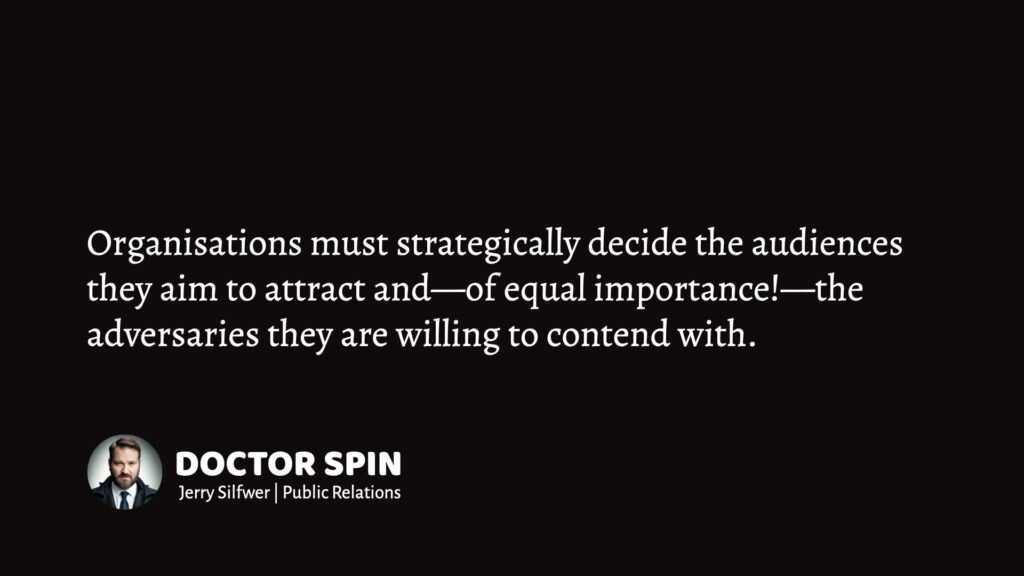“Correct” isn’t necessarily good public relations.
Some people argue that their actions shouldn’t result in bad public relations because they’re a) legally in the clear and b) factually correct.
I’m sorry, but that’s not the way PR works.
Here we go:
The Norman Axiom
Many years ago, I stumbled across this meme with “Norman” complaining about the noise from the nearby airfield.
I call this the Norman Axiom.

I tell the story about Norman to illustrate two key points in public relations:
If the paradox of prominence is the question, then the Norman Axiom is the answer.
Learn more: The Norman Axiom

THANKS FOR READING.
Need PR help? Hire me here.

What should you study next?
Good PR vs Bad PR
In public relations, saying the right things will not be enough if you do the wrong things.
Doing the wrong things + saying the wrong things = bad PR
Doing the wrong things + saying the right things = bad PR
Doing the right things + saying the wrong things = bad PR
Doing the right things + saying the right things = good PR
What does this mean?
Every now and then, I have to point out that some organisational problems aren’t PR problems; they’re organisational problems.
With PR activities, you can fix public relations problems but can’t fix organisational problems (harmful products or services, unethical practices, illegal practices, etc.).
Learn more: Good PR vs Bad PR
What should you study next?
The Paradox of Prominence
The “dark side” of what drives people’s engagement can be a true PR challenge. This phenomenon, where every strength inherently possesses a corresponding downside, can be called the paradox of prominence.

An example of this paradox is the halo effect, where physical attractiveness becomes an asset for a spokesperson. Attractiveness often leads to positive biases; attractive individuals are frequently perceived as more credible and competent. 1Eagly, A. H., Ashmore, R. D., Makhijani, M. G., & Longo, L. C. (1991). What is beautiful is good, but…: A meta-analytic review of research on the physical attractiveness stereotype. … Continue reading 2Silfwer, J. (2023, December 17). The Halo Effect: Why Attractiveness Matters in PR. Doctor Spin | The PR Blog. https://doctorspin.net/halo-effect/
However, this same attribute can spark negative reactions. Critics might claim that the individual’s success or visibility is primarily due to their looks, undermining their competencies. This duality illustrates how the qualities that draw positive attention can simultaneously attract criticism and scepticism.
Competence, another valuable trait, often encounters similar pitfalls. Highly competent individuals inspire confidence and admiration. Nevertheless, this competence can be perceived negatively when willfully interpreted as arrogance. Studies suggest that while competence garners respect, it can also lead to social penalties, such as envy and resentment. 3Fiske, S. T., Cuddy, A. J. C., Glick, P., & Xu, J. (2002). A model of (often mixed) stereotype content: Competence and warmth respectively follow from perceived status and competition. Journal of … Continue reading
Examples of the Paradox of Prominence
The paradox of prominence seems to be an inherent aspect of human interest dynamics.
| Prominence | Positive Outcome | Negative Outcome |
|---|---|---|
| Physical attractiveness | Enhanced credibility and trust | Accusations of superficial success |
| High competence | Respected and trusted as an expert | Perceived as arrogant or unapproachable |
| Charisma | Ability to inspire and attract followers | Viewed as manipulative or insincere |
| Strong advocacy | Increased support and mobilization for a cause | Target of intense criticism from opponents |
| Wealth | Seen as successful and influential | Resentment and accusations of greed or unfairness |
| Assertiveness | Effective leadership and decision-making | Labeled as domineering or aggressive |
| Innovation | Admired for creativity and forward-thinking | Resistance to change and criticism from traditionalists |
| High visibility | Greater recognition and influence | Increased scrutiny and loss of privacy |
| Generosity | Viewed as kind-hearted and philanthropic | Suspected of ulterior motives |
| Success in competitive fields | Role model and symbol of achievement | Envy and attempts to undermine accomplishments |
We must recognise that with every increase in visibility, there is a corresponding increase in scrutiny and criticism.
“Being Loved by Everyone”
Earning public awareness comes with inevitable costs.
In the quest for greater visibility and influence, it is critical to acknowledge that “being universally well-liked” is a naïve and unrealistic goal.
“Being loved by everyone” can never be a viable public relations strategy.
By strategically harnessing this paradox, public relations professionals can manage public perception by internalising expected “downsides” as additional awareness drivers.
Learn more: The Paradox of Prominence
Annotations
| 1 | Eagly, A. H., Ashmore, R. D., Makhijani, M. G., & Longo, L. C. (1991). What is beautiful is good, but…: A meta-analytic review of research on the physical attractiveness stereotype. Psychological Bulletin, 110(1), 109 – 128. https://doi.org/10.1037/0033 – 2909.110.1.109 |
|---|---|
| 2 | Silfwer, J. (2023, December 17). The Halo Effect: Why Attractiveness Matters in PR. Doctor Spin | The PR Blog. https://doctorspin.net/halo-effect/ |
| 3 | Fiske, S. T., Cuddy, A. J. C., Glick, P., & Xu, J. (2002). A model of (often mixed) stereotype content: Competence and warmth respectively follow from perceived status and competition. Journal of Personality and Social Psychology, 82(6), 878 – 902. https://doi.org/10.1037/0022 – 3514.82.6.878 |


